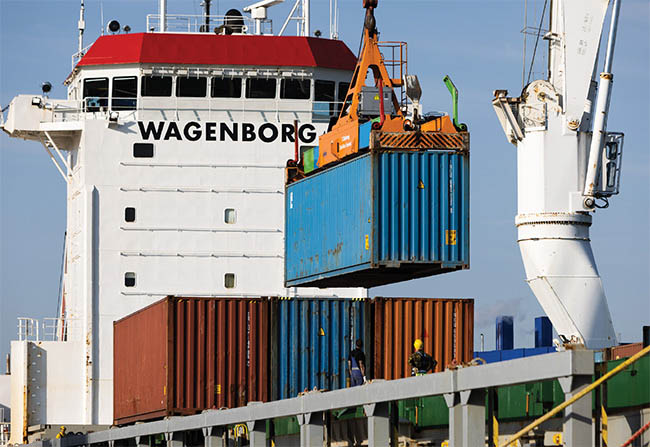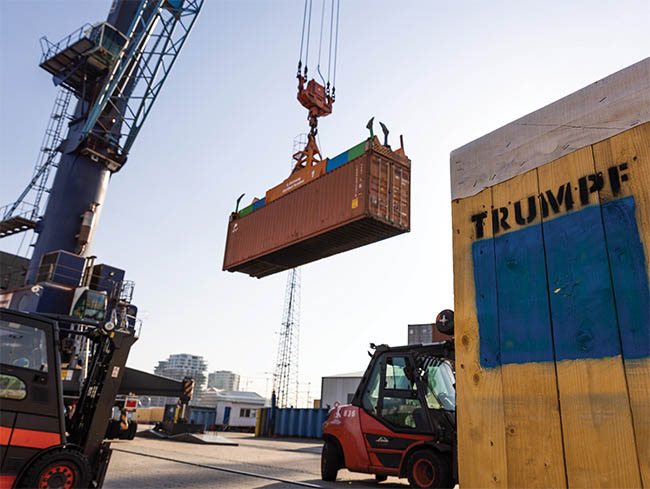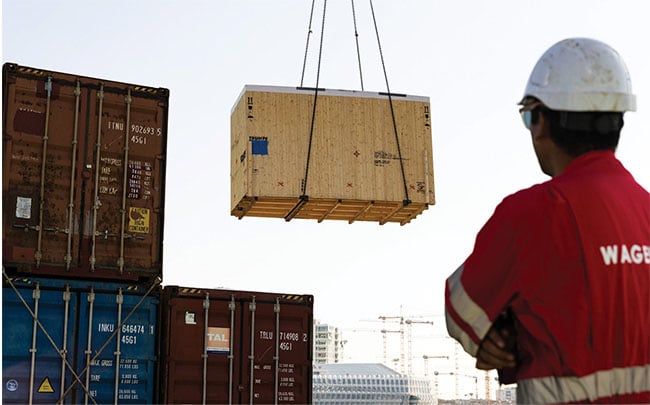With the effects of a multiyear pandemic and a war in Ukraine continuing to permeate global commerce, logistics operations face a treacherous set of circumstances. For sea freight transportation, increased loading times at port — which then leads to longer wait times for loaded vessels before departure — means goods often arrive after significant delays.
Paired with rising shipping costs, the situation has necessitated that logistics managers consider creative solutions to a costly problem.
Over the past summer, to bypass the logistics logjam, TRUMPF chartered a deep-sea container vessel. While global companies in the U.S. — such as Coca-Cola, Walmart, and IKEA — had already rented ships in 2021, the laser giant’s decision to charter a ship placed TRUMPF in a rare class among players in the machine industry.
The ship ultimately transported 49 TRUMPF laser systems, primarily machines and production parts used for cutting and bending, from Hamburg, Germany, to the Port of New York and New Jersey.
Frank Nesselberger, head of global
machine logistics at TRUMPF, led the coordinated effort. According to Nessel-
berger, up to 90% of sea freight failed to meet its initial target arrival date at the height of the disruption. The company therefore elected to pursue the nontraditional shipping method to fulfill customer orders.

Much of TRUMPF’s cargo via freight is considered ‘out of gauge,’ meaning that certain machines do not fit in a standard shipping container. Some of the machines were placed on the charter because the company was unable to transport them the standard way, it said. Courtesy of TRUMPF SE + Co. KG.
Before 2020, it took about 25 days to move machines on a vessel from TRUMPF’s factory in Germany to New Jersey, he said. Even accounting for the time that a vessel spends on the water, the charter enabled TRUMPF to complete the trans-Atlantic shipping process up to four weeks faster this year than it would have via a standard shipping operation.
Though the approach opened the door to new issues to consider, the outcome proved a positive business case in TRUMPF’s second-largest market. Sales to the U.S. alone reached nearly $640 million for the company as of the June 30 close of its 2021-2022 fiscal year.
Photonics Media news editor Jake Saltzman spoke with Nesselberger about the charter and the business environment that prompted the company’s decision. A lightly edited version of their conversation follows.
The global supply chain has been in a state of flux for over 2 1/2 years.
Why did TRUMPF decide to charter a shipping vessel?
Unreliability in the supply chain has created an extremely volatile logistics environment. Both the extent of the fluctuation as well as the different types of negative circumstances that we have faced for over 2 1/2 years make logistics very difficult. Before 2020, shipping
processes were fixed, you could say. There were few variables that would affect a vessel. Now, we may get updates about changes to a single trip up to 40× before it departs. When this happens, our entire process chain — from the factory, to arrival at the port, to packaging and loading, even paperwork — might need to be adjusted. Colleagues who have spent their lives in the supply chain have told me that they’ve never worked in an environment like this.
In our sea freight operations alone, we have made many adjustments since March 2020. We have used multiple types of ships for the last two years — including using the roll-on/roll-off vessels that you typically see used to transport cars. Over this time, we explored our transportation options and what we might be able to do to maintain, or even improve, performance in customer service.
So, this decision was not based on one event. It was about what we could do to improve our processes under the current set of circumstances, such as long wait times at port and the increased costs of shipping containers.

The chartered vessel carried 49 laser systems from the port at Hamburg, Germany, to the Port of New York and New Jersey. Courtesy of TRUMPF SE + Co. KG.
How has TRUMPF been affected by the current logistics climate?
Our operation requires us to move large, heavy, assembled machines. With our machines, we are already near the breaking point for what fits inside a standard shipping container.
In fact, some of the machines that we transport do not fit in a standard shipping container, which means our cargo is “out of gauge.”
On the charter, many of the 49
machines required multiple containers.
A few of the machines went onto the charter because there were issues with transporting them the standard way.
Sea freight is already a slower moving process than air freight. Added to that is a lack of resilience in the supply chain. Weather events, even on the other side of the world, are leading to longer delays of weeks or even months. There have also been more delays.
Before 2020, it took on average up to
25 days to move machines from our factory in Germany onto a container vessel in Hamburg and receive them at the harbor in New Jersey. For us, that was a much faster, more efficient process than chartering a vessel. In 2022, wait times at the port mean machines can sit loaded onto a vessel for multiple weeks. With this charter, some of the machines we transported had wait times of just two days.
Shipping vessels travel on the water for about 12 days from Hamburg to New Jersey. Before 2020, charters would never have been competitive with standard
shipping method. Now, we ultimately
estimated that some of the machines on the chartered vessel arrived at the destination up to four weeks faster than they would have if we had shipped them using the standard method in 2022. For us, that was a much faster, more efficient process than chartering a vessel.
How did TRUMPF’s processes change when the company used the chartered vessel versus standard shipping?
The main consideration is the current logistics environment and how that affects the processes in the chain of operation. Within this, there are two things to consider: changes to processes from before 2020, to 2022, and changes from standard sea freight shipping to the use of a charter.
Normally, depending on the machine to transport, organizing transport starts four to six weeks before the vessel leaves the harbor. There are steps we must complete before the vessel leaves the harbor — such as booking space on the vessel, renting shipping containers, bringing the machines to the packaging company, and loading the machines onto the ship.
With a charter, your timeline involves more steps and considerations. We have capacity bottlenecks to consider. We must coordinate shipping, packaging, and loading. All the documentation and customs clearances were our responsibility. And we were also responsible for the charter
at the other end.
There is a reason we have used container vessels for shipping: They are cost-efficient compared to other types of vessels. Under normal circumstances, they give you the best lead times that you can achieve. In the 1950s, these container vessels were new and considered the
future of commercial shipping. We’ve used them now for 70 years.
The processes that we used — largely unchanged since the 1950s — were no longer reliable, as they were before 2020. Costs have increased. If we use the exact same processes going forward in this environment that we have used since the 1950s, in some ways it is like going back to the 1950s.

Due to the increased shipping costs and wait times at port that began in 2020, in the summer of this year, TRUMPF chartered its own deep-sea container ship via a logistics company. TRUMPF said that, compared to the latest standard shipping timelines, the charter improved the arrival times of its laser systems from Europe to North America by four weeks. Courtesy of TRUMPF SE + Co. KG.
How unusual is it for a company such as TRUMPF to charter a ship?
It’s not normal at all. This is not something that we have done before, and it is not something that we see comparable companies doing.
We did see some other companies, such as wholesalers, choosing this option. But in the machine industry where we are working, we hadn’t heard of companies choosing this option.
On the one hand, this business case gave us complete control of the project. We were able to pull more strings. But on the other, there were more strings that we needed to pull. That was the greatest challenge for us and what I would tell a company that might choose this option.
I only can suggest that you go far into the details and select the right partners.
With this charter completed, are there future chartering opportunities for industry-to-industry or cross-industry collaboration?
We asked this question to ourselves, and we’ve been asked this question by others. This was a quite complex operation.
Adding companies increases complexities. The risk is having too many people with different interests and their partners
— it becomes quite hard to handle. When
you charter a vessel, you become responsible for coordinating aspects of the
operation with your partners before the ship leaves the port, as well as after it arrives.
We learned that we really needed to closely monitor our merchandise all the way through the operation because of the number of processes involved. One event affecting one process could affect the rest of the chain. Every department has a deadline. When there are more departments involved, there are more deadlines. A big challenge was ensuring that all machines arrived at the harbor in time, all within a period of a few days, for example.
This operation required spending time at port to understand the situation at the harbor in Hamburg, which included a workers’ strike. We had two days, in some cases, to get machines onto the charter.
In the past, we’ve had two weeks.
Replicating that with others would be quite difficult.
You described this experience as a ‘positive business case.’ Will TRUMPF plan to use this method again, and what is the company doing to continue to
adapt its business logistics?
It was absolutely a positive business case, as well as a learning experience for the future. Almost every machine went to
a different customer. We showed our customers that we can go beyond borders in a difficult environment.
This is a logistics win, but it is not only logistics. It is more about focusing on our end-to-end processes — tearing down borders between production, logistics, service, etc. It’s more about improving supply chain planning. We want to be able to have the chance to react more and see problems earlier. Logistics is part of that and not a silo in between. The main thing we are working on is flexibility. So, we plan to test some new options. We could perform trial shipments with different carriers, for example.
The mindset that we keep, that led us to select a charter, has not changed. We are asking ourselves the same question every day: What can we do to be flexible to the challenges that will come up in the next weeks or months?